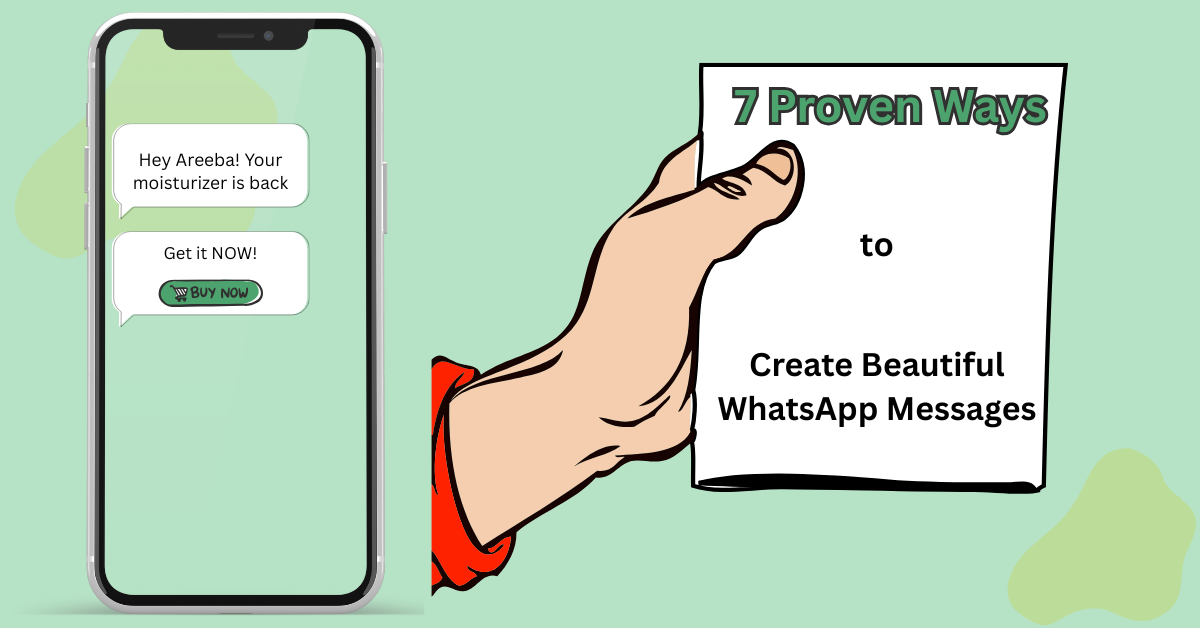This is a hands on expert level guide that explains every message type, the rules you must follow, creative formats that perform, copy recipes that drive replies, a technical checklist to avoid rejections, and advanced tricks most guides miss.
What You Will Learn
If you want to design WhatsApp messages that look visually appealing and also drive measurable results you will discover:
- How to pick the right message type for the right situation
- How to write exact copy that inspires action
- How to combine images and product cards so your messages feel premium and polished
- How to avoid template rejections from WhatsApp
- How to measure results and improve future campaigns
- How to ensure compliance with platform rules and opt in laws
WhatsApp Business Message Types and When to Use Each
1. Template Messages
These are designed for business initiated messages that fall outside of the 24 hour live conversation window.
Ideal for:
- Order updates
- Delivery notifications
- Appointment reminders
- Time sensitive promotions
The key point to remember is that templates must be created and approved by WhatsApp before you can send them. This approval step ensures consistency and quality across the platform.
2. Free Form Messages
Free form messages allow you to have natural back and forth communication with customers. You can send them when the conversation is started by the customer or when you are within the 24 hour customer service window.
Inside that window you are free to send plain text, images, videos, documents, or audio without restriction. Outside of that time limit, you must return to using approved templates.
This message type is perfect for building rapport, answering specific questions, and providing a personal touch.
3. Interactive Messages
Interactive messages come with either quick reply buttons or structured list messages. They are ideal for guiding customers toward their next step with minimal effort on their part.
Benefits:- Reduce friction by limiting typing
- Increase response rates by giving clear choices
- Keep conversations structured and focused
4. Media Messages and Catalogs
Media messages let you send images, videos, documents, and audio directly within WhatsApp. Catalog messages display products as clickable cards that contain an image, title, price, and link to view details.
Best practices for media:- Keep file sizes small for quick loading
- Use simple and legible visuals
- Include short captions with clear actions
Deep Dive: Template Messages
Template Messages are pre-approved message formats that WhatsApp requires businesses to use when sending messages outside the 24-hour customer service window. Think of them as pre-set text + variables that allow you to send important updates, promotions, or alerts at scale — but only after WhatsApp reviews and approves them. This approval ensures your message follows both platform guidelines and user experience standards.
Each template is reusable and can be personalized with placeholders (like the customer’s name or order number) so it feels tailored, not generic. Once approved, you can send these templates instantly without waiting for a new review each time.
Using templates correctly is critical — a poorly structured or non-compliant template can get rejected, delaying your campaign and affecting customer engagement.
How Templates Are Organized:
- Category: Every template must fall under one of three categories — Marketing, Utility, or Authentication.
- Placeholders: Use the approved double bracket format such as
{{1}}to insert dynamic data. - Buttons: Follow WhatsApp’s rules for allowed button types and the maximum number you can use.
- Copy: Keep the text concise and focused on one action per template. Avoid mixing multiple objectives in a single message.
Common Mistakes to Avoid
- Sending overly long or cluttered messages that overwhelm the recipient
- Using words like “Free” or “Urgent” excessively, which can lead to rejections
- Forgetting to collect proper opt-in before sending marketing content
- Sending messages at inconvenient hours for the customer’s time zone
- Skipping media optimization, leading to slow loading times
Advanced Tactics Most Guides Miss
Level up execution with these often overlooked practices:
Final Notes
If you follow these rules such as having a clear call to action, keeping friction low, and presenting creative that looks polished, you will almost always see better reply rates and stronger conversions.
- Audit all your existing templates and match them with the right categories
- Build and test at least three interactive micro flows
- Add alt text to all media and create a fallback SMS plan
- Link your campaign metrics directly to actual conversions





